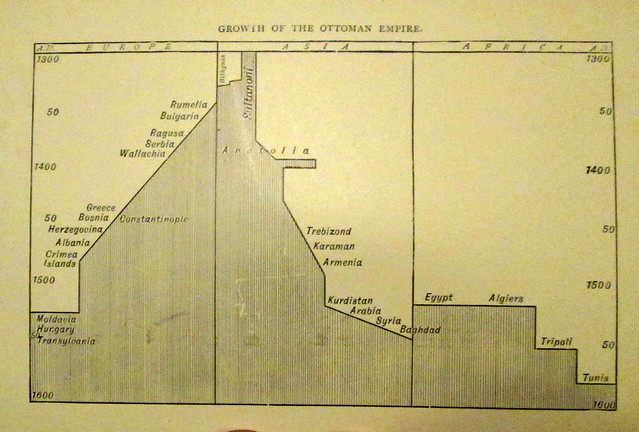 |
| The Ottoman State's Era of Stagnation and Retreat |
Of course the critique of Ottoman decline is motivated by the fact that there really were generations of Orientalist scholars writing some ridiculous things. That the Ottoman Empire declined because it could no longer bear the weight of its religious fanaticism, because it was not quick enough to recognize the superiority of European civilization or because its nomadic Turkish rulers could never learn the civilized art of administration. The religious explanation of Ottoman decline has been perhaps the most enduring. Particularly when people like Paul Kennedy sought to explain "the rise and fall of great powers" the Ottoman Empire always appears as the Muslim / Middle Eastern country that almost made it, an approach which inevitably tends to cast the reason it didn't make it in a religious or civilizational light. The religious explanation of Ottoman decline also served quite nicely as a justification for Kemalist reforms, which supposedly sought to recreate the secular mentality that characterized the Empire in its golden age.
Against the simple narrative that the Ottoman Empire reached its peak in the 16th century, perhaps under Suleiman the Magnificent, then slowly declined over the next few centuries into a state of tottering sick-man obsolescence, historians have offered a number of corrections ranging from the somewhat obvious to the profound.
The most straightforward might be that even as the Ottoman Empire declined relative to its European rivals, it continued to advance technologically, militarily and economically in absolute terms. I think people generally realize this is what's implied by decline, but in case anyone doesn't let's be clear: if, through the vagaries of time travel, the 18th century Ottoman army went up against the Ottoman army that conquered Constantinople in the 15th century, the 18th century Ottomans would totally win.
[Sorry, my real goal in writing this post wasn't to just ramble about narratives of Ottoman decline, but to share a few graphics that offer interesting visualizations of the expansion and collapse of Ottoman power. This one, from a Republican Era history about the siege of Vienna, offers a two dimensional view of Ottoman power measured by kilometers of territory controlled per year.]
Some scholars have questioned the tendency to judge decline purely in terms of the ability to win wars. Which is fair up to a point, but distracts from some of the more interesting work that's been done on why the Ottomans stopped winning wars when they did. Gabor Agoston, for example, has made the case that, contrary to what many assumed, technology actually had little bearing on military power up until the 19th century, and that even in some realms where the Ottomans seemed to fall behind technologically, such as gunpowder production, their problems had more to do with economics and manufacturing than the quality of their military technology per se.
Other scholars have argued that maybe the Ottomans just didn't want to win wars, or control more territory anymore.
On the political side, scholars such as Virginia Aksan have argued that the decentralization that occurred in the Ottoman Empire in the 16th century was not simply a sign of encroaching decline, but rather a conscious strategy that served to preserve Ottoman power. Perhaps. But as wise or effective as this strategy may have been at the time, it seems like there's no escaping the fact that by the 18th century it left the Ottomans at a military disadvantage in conflicts with European powers who had been able to more effectively centralize state control during this period. When faced with loss of territories like Egypt and later Bulgaria in the 19th century, the Ottoman government made a conscious effort to preserve some kind of nominal authority over breakaway regions, going to sometimes elaborate lengths to display symbolic sovereignty over the Egyptian Khedive or Eastern Rumelia. After World War One, the Turkish Republic took the opposite tactic, embracing the rhetoric of the nation state in asserting full sovereignty over all the territory within its borders and no sovereignty over any territory outside of them. Given the realities of late 19th and early 20th century statecraft, this proved to be a better approach. The result was that by the end of the 20th century, the trajectory of Ottoman/Turkish state's military and economic fortunes actually looked quite similar to that of other Mediterranean states.
Another neat visualization of the Ottoman Empire's territorial rise and fall showing geographic conquests schematically as width per year. This map comes from a book in the ARIT library whose title proved a victim of my shoddy note-taking.







